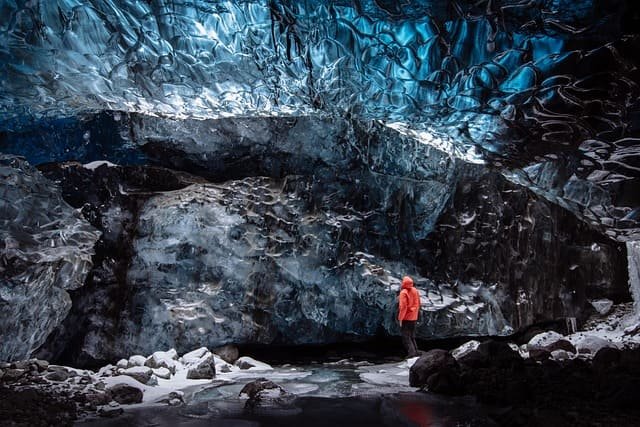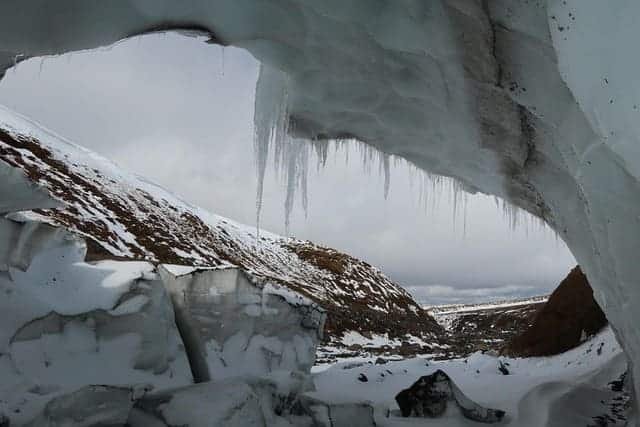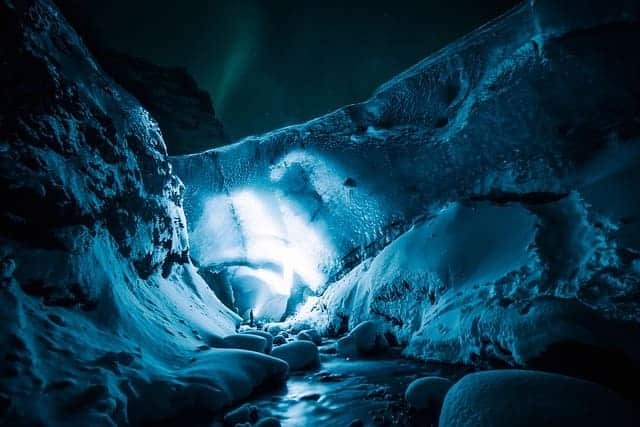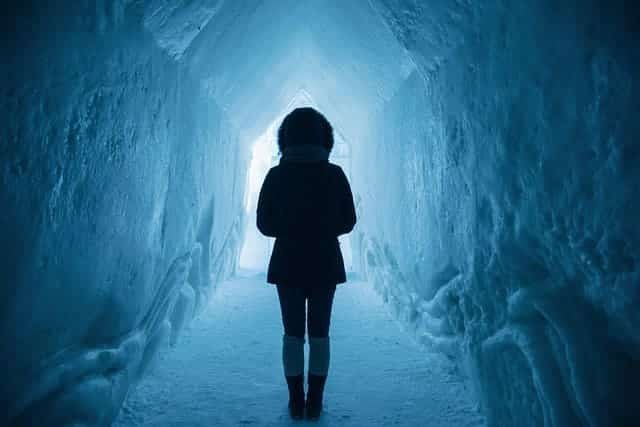If you are asking yourself “Where are the most exciting ice caves in Europe?”, the quick answer is that you’ll find them in Austria, Iceland, Switzerland, France, and even Slovakia. Each country hides frozen worlds beneath mountains and glaciers that you can actually step inside, explore, and photograph. The good news? These magical places are accessible for tourists, with guided tours, clear transport routes, and options for every budget. From the world’s largest ice cave in Austria to surreal glowing blue tunnels in Iceland, the experience of walking through these caves feels like entering another planet.

Below, we’ll explore exactly where you can go, how much it will cost, where to stay nearby, and what you can do in each place.
Austria – Eisriesenwelt Ice Cave
When travelers ask “Where are the most exciting ice caves in Europe?”, Austria almost always comes up first. The Eisriesenwelt Ice Cave near Werfen is the largest ice cave in the world, stretching over 42 kilometers.
How to Get There
From Salzburg, you can take a 40-minute train to Werfen, then hop on a shuttle bus that takes you close to the cave entrance. A steep cable car ride gets you right to the starting point of the tour.
Cost and Tours
Entrance tickets including the cable car cost about €35 per adult and €18 per child. Guided tours are included, lasting about 70 minutes.
Where to Stay
- Budget: Pension Vogt (around €60 a night) in Werfen
- Mid-range: Werfenerhof Hotel (€120 a night) with mountain views
- Luxury: Salzburg city boutique hotels (€200+) if you prefer a base in town
What to Expect
Inside, you’ll see frozen waterfalls, crystal-like walls, and ice formations that glow under lantern light. It’s chilly (around 0°C), so warm clothing is essential.
Iceland – Vatnajökull Glacier Ice Caves
Another top answer to “Where are the most exciting ice caves in Europe?” is Iceland. Under the massive Vatnajökull Glacier, natural blue ice caves form each winter.
How to Get There
From Reykjavik, drive about 5 hours or book a tour that includes pickup. Most tours start from Jökulsárlón Glacier Lagoon.
Cost and Tours
Prices are higher here, usually between €150 and €200 for a 3-hour guided tour including safety gear. These tours are seasonal, only available from November to March.
Where to Stay
- Budget: Hali Country Hotel (around €110 a night)
- Mid-range: Fosshotel Glacier Lagoon (€180+)
- Luxury: Adventure hotels in Reykjavik (€250+) if you don’t mind the long transfer
What to Expect
The caves are famous for their glowing sapphire-blue ice, sculpted tunnels, and eerie silence. They change every year as the glacier shifts, so no two visits look the same.
Switzerland – Rhone Glacier Ice Grotto
If you’re still wondering “Where are the most exciting ice caves in Europe?”, Switzerland offers an unusual one: the Ice Grotto carved inside the Rhone Glacier in Valais.
How to Get There
From Andermatt, it’s a scenic drive of about 1.5 hours. Many travelers combine it with a Swiss mountain road trip.
Cost and Tours
Entrance to the grotto costs about €8 per person. It’s one of the most affordable ice cave experiences in Europe.
Where to Stay
- Budget: Mountain lodges near Oberwald (€70 a night)
- Mid-range: Hotel Belvédère (€130+) right by the glacier
- Luxury: Zermatt resorts (€250+) if you want alpine luxury nearby
What to Expect
Here, instead of a wild natural cave, you walk through a 100-meter-long hand-carved tunnel of ice. It’s a surreal glowing passage with shifting colors and a very family-friendly option.
France – Mer de Glace Ice Cave, Chamonix
When people search “Where are the most exciting ice caves in Europe?”, France’s Mont Blanc area always makes the list. The Mer de Glace near Chamonix is carved each year into the glacier.
How to Get There
Take the Montenvers Railway from Chamonix, which drops you right at the glacier. A short gondola ride and a hike down stairways bring you to the entrance.
Cost and Tours
Tickets for the train and entrance are about €35 for adults and €28 for kids.
Where to Stay
- Budget: Hostels in Chamonix (€40–60 a night)
- Mid-range: Hotel Le Faucigny (€120+) in the town center
- Luxury: Chamonix ski resorts (€300+) with spa access
What to Expect
Inside, you’ll see ice sculptures, frozen walls glowing with blue and white tones, and an immersive experience of the Mont Blanc glacier. Because it’s re-carved each summer, it’s slightly different every year.
Slovakia – Dobšinská Ice Cave
Slovakia might not be the first answer when people ask “Where are the most exciting ice caves in Europe?”, but Dobšinská Ice Cave is a hidden treasure.
How to Get There
From Poprad, it’s a 45-minute train or bus ride to the village of Dobšiná, then a short hike to the cave.
Cost and Tours
Entrance is about €10 for adults and €5 for kids, making it one of the cheapest ice caves to visit. Guided tours last about 30 minutes.
Where to Stay
- Budget: Guesthouses in Dobšiná (€40–60 a night)
- Mid-range: Hotels in Poprad (€100–120)
- Luxury: Mountain resorts in the High Tatras (€200+)
What to Expect
The cave is filled with frozen halls, icy stalactites, and huge ice sheets. It feels untouched and wild compared to more tourist-heavy caves.
Extra Ice Cave Spots Worth Mentioning
If you’re still asking “Where are the most exciting ice caves in Europe?”, here are some bonus locations:
- Austria’s Dachstein Ice Cave near Hallstatt – €35 ticket including cable car, with shimmering frozen formations and underground tours.
- Italy’s Marmolada Glacier Ice Cave in the Dolomites – reachable by cable car, stunning natural ice tunnels.
- Germany’s Schellenberg Ice Cave – guided tours from May to October, costs around €15.

Budget Tips for Ice Cave Trips
- Travel off-season: Outside peak holidays, hotel prices can drop by 30%.
- Combine transport passes: In Austria, Germany, and Switzerland, regional passes include trains and cable cars at discounted prices.
- Book tours early: Iceland and Chamonix ice cave tours sell out fast; booking months ahead saves money and guarantees spots.
- Stay in nearby villages: Choosing small guesthouses outside tourist towns can save €50–100 a night.
Safety and Preparation
- Always wear warm layers (0°C to -5°C inside caves).
- Good boots with grip are essential.
- Guided tours are required for most caves for safety reasons.
- Don’t try to explore on your own ice caves shift and can be dangerous.

Final Thoughts
So, where are the most exciting ice caves in Europe? They’re scattered across Austria, Iceland, Switzerland, France, and Slovakia, each offering something unique. Austria’s Eisriesenwelt is the biggest, Iceland’s caves glow the bluest, Switzerland’s grotto is the most family-friendly, France’s Mont Blanc cave is the most scenic, and Slovakia’s cave is the most affordable hidden gem.
No matter which one you choose, stepping inside an ice cave in Europe feels like entering another world. And with tours, transport, and stays available for every budget, it’s an adventure every traveler should experience at least once.
People also ask about: How to Travel Europe Without Flying?

